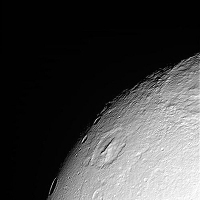Enceladus plumes and Dione
 |
|
Saturn's moon Dione |
A day after the flyby, Cassini imaged Dione, another of Saturn's moons. From a distance of 44 000 km, features like impact craters are clearly visible on the side of the moon that faces away from the Sun.
Notes for editors
The Cassini–Huygens mission is a cooperative project between NASA, ESA and the Italian space agency, ASI. The Jet Propulsion Laboratory, a division of the California Institute of Technology in Pasadena, manages the mission for NASA's Science Mission Directorate, Washington, DC, USA. The Cassini orbiter and its two cameras were designed, developed and assembled at JPL. The imaging operations centre is based at the Space Science Institute in Boulder, Colorado.
(This article was originally published on ESA's Space Science Portal.)

